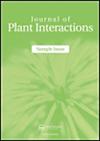抑制叶片生长和光合能力作为氮敏感和耐阴植物三七对氮缺乏的适应策略
IF 3.3
3区 生物学
Q2 PLANT SCIENCES
引用次数: 1
摘要
摘要光合作用对缺氮反应敏感。然而,耐荫和高氮敏感物种对缺氮的适应尚不清楚。对不同氮水平下生长的耐荫高氮品种三七的叶片形态生理特性、光合性能相关参数进行了研究。N0生长的三七中氮含量和叶绿素含量较低。获得了N15生长三七叶片形态生理性状、光合速率和光合氮利用效率(PNUE)的最大值。N0种植的植物中,叶片N分配到羧化和光收集系统成分中的系数显著高于其他植物。N0和N7.5植株表现出较高的K期。N的加入降低了单位面积光能(ABS/RC和TRO/RC)和非光化学猝灭(NPQ)的吸收和捕获。在N0生长的植物中,光化学猝灭(qP)、电子传输速率(ETR)和光系统II的有效量子产率(ξPSII)降低。光捕获和利用能力的降低不仅导致PNUE的降低,还导致PSII反应中心的损伤。总之,抑制叶片生长和光合能力是高氮敏感和耐荫植物应对缺氮的重要策略。本文章由计算机程序翻译,如有差异,请以英文原文为准。
Suppression of leaf growth and photosynthetic capacity as an acclimation strategy to nitrogen deficiency in a nitrogen-sensitive and shade-tolerant plant Panax notoginseng
ABSTRACT Photosynthesis is susceptible in response to nitrogen (N) deficiency. However, the acclimation of shade-tolerant and high-N sensitive species to N deficiency is unclear. Leaf morpho-physiological traits, photosynthetic performance related parameters were examined in a shade-tolerant and high-N sensitive species P. notoginseng grown under different N levels. Lower N content and Chl content were recorded in the N0-grown P. notoginseng. The maximum values of leaf morpho-physiological traits, photosynthetic rate, and photosynthetic N use efficiency (PNUE) were obtained in the N15-grown P. notoginseng. Coefficients for leaf N allocation into the carboxylation and light-harvesting system components in the N0-grown plants were significantly higher than others. N0 and N7.5 plants showed higher K phase. N addition decreased the absorption and capture of the light energy per unit area (ABS/RC and TRO/RC) and non-photochemical quenching (NPQ). Photochemical quenching (qP), electron transport rate (ETR), and effective quantum yield of photosystem II (ϕPSII) were reduced in the N0-grown plants. The reduction of light-harvesting and utilization capacity not only leads to a decrease in PNUE, but also induces the damage of PSII reaction center. Overall, the inhibition of leaf growth and photosynthetic capacity is an essential strategy for high-N sensitive and shade-tolerant plants in response to N deficiency.
求助全文
通过发布文献求助,成功后即可免费获取论文全文。
去求助
来源期刊

Journal of Plant Interactions
PLANT SCIENCES-
CiteScore
5.30
自引率
6.20%
发文量
69
审稿时长
>12 weeks
期刊介绍:
Journal of Plant Interactions aims to represent a common platform for those scientists interested in publishing and reading research articles in the field of plant interactions and will cover most plant interactions with the surrounding environment.
 求助内容:
求助内容: 应助结果提醒方式:
应助结果提醒方式:


